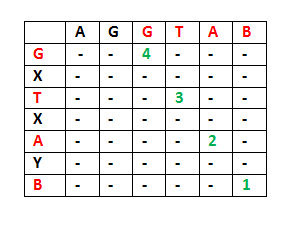Longest Common Subsequence
Now, we will look through how to solve a popular dynamic programming problem,
LCS or longest common subsequence problem.
1) Optimal Substructure:
Let the input sequences be X[0..m-1] and Y[0..n-1] of lengths m and n respectively. And let L(X[0..m-1], Y[0..n-1]) be the length of LCS of the two sequences X and Y. Following is the recursive definition of L(X[0..m-1], Y[0..n-1]).
If last characters of both sequences match (or X[m-1] == Y[n-1]) then
L(X[0..m-1], Y[0..n-1]) = 1 + L(X[0..m-2], Y[0..n-2])
If last characters of both sequences do not match (or X[m-1] != Y[n-1]) then
L(X[0..m-1], Y[0..n-1]) = MAX ( L(X[0..m-2], Y[0..n-1]), L(X[0..m-1], Y[0..n-2]) )
Examples:
1) Consider the input strings “AGGTAB” and “GXTXAYB”. Last characters match for the strings. So length of LCS can be written as:
L(“AGGTAB”, “GXTXAYB”) = 1 + L(“AGGTA”, “GXTXAY”)
2) Consider the input strings “ABCDGH” and “AEDFHR. Last characters do not match for the strings. So length of LCS can be written as:
L(“ABCDGH”, “AEDFHR”) = MAX ( L(“ABCDG”, “AEDFHR”), L(“ABCDGH”, “AEDFH”) )
So the LCS problem has optimal substructure property as the main problem can be solved using solutions to subproblems.
2) Overlapping Subproblems:
Following is simple recursive implementation of the LCS problem. The implementation simply follows the recursive structure mentioned above.
/* A Naive recursive implementation of LCS problem */
#include <bits/stdc++.h>
using namespace std;
int max(int a, int b);
/* Returns length of LCS for X[0..m-1], Y[0..n-1] */
int lcs( char *X, char *Y, int m, int n )
{
if (m == 0 || n == 0)
return 0;
if (X[m-1] == Y[n-1])
return 1 + lcs(X, Y, m-1, n-1);
else
return max(lcs(X, Y, m, n-1), lcs(X, Y, m-1, n));
}
/* Utility function to get max of 2 integers */
int max(int a, int b)
{
return (a > b)? a : b;
}
/* Driver code */
int main()
{
char X[] = "AGGTAB";
char Y[] = "GXTXAYB";
int m = strlen(X);
int n = strlen(Y);
cout<<"Length of LCS is "<< lcs( X, Y, m, n ) ;
return 0;
}
Comments
Post a Comment